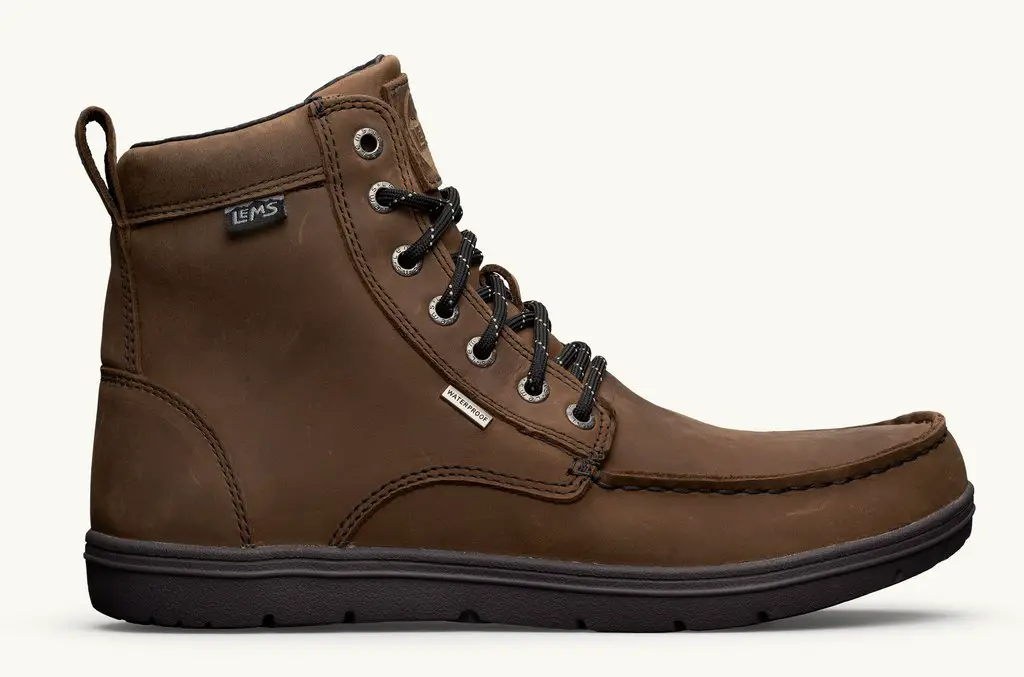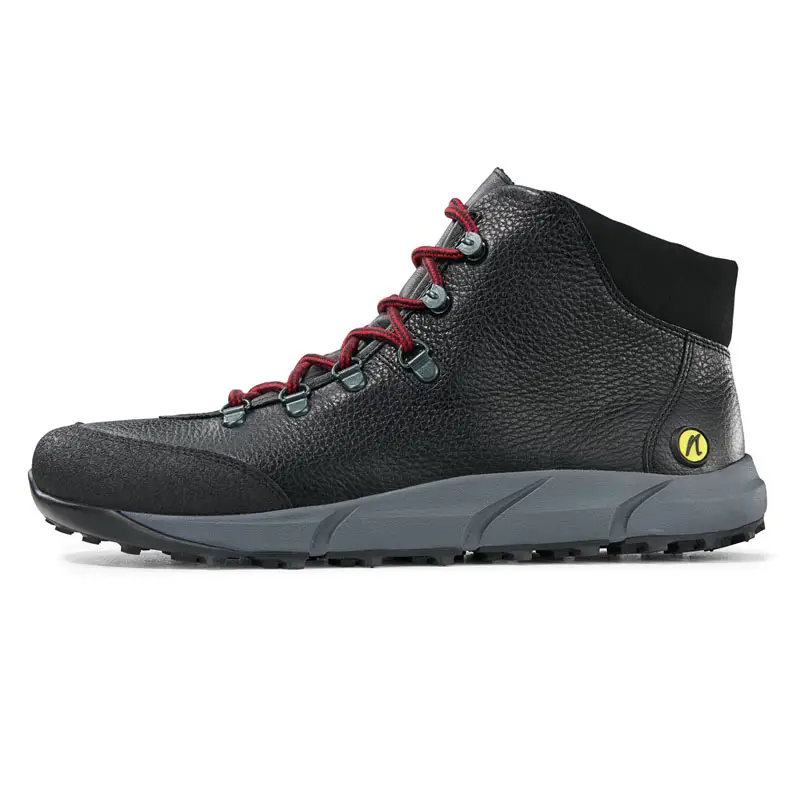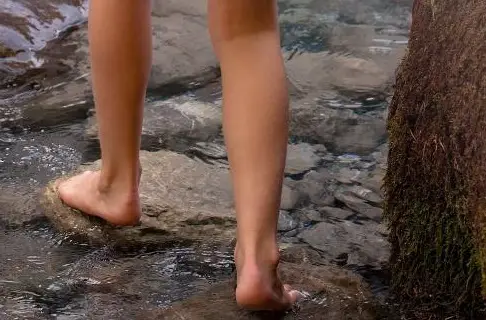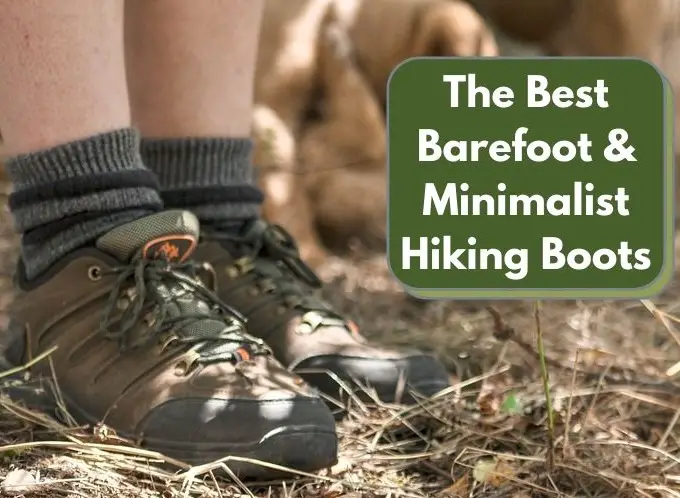As barefoot hiking continues to grow in popularity, it’s no surprise that many of our readers have been asking if barefoot hiking boots are a good choice for them.
With that question in mind, we set out to create this comprehensive guide where we reviewed the best minimalist hiking boots and barefoot hiking boots on the market today, along with what to look for when making your selection.
Here are 5 key features you should look for when choosing barefoot-style hiking boots:
- Good Traction: You need grip on a variety of surfaces
- Toe Protection: Toe caps are a must
- Breathability: Ventilated materials keep your feet dry and blister-free
- Waterproof: Keeping water off your feet in a variety of conditions is crucial
- Lightweight: Most barefoot footwear will be lightweight, but minimizing weight is optimal
Read More: Barefoot Hiking Boots Buying Guide
Our Top Barefoot Hiking Boot Picks
| Best Overall Barefoot Hiking Boots | Vivobarefoot Tracker FG II Men’s Vivobarefoot Tracker FG II Women’s |
| Best Overall Minimalist Hiking Boots | Xero Xcursion Men’s Xero Xcursion Women’s |
| Best Lightweight Barefoot Hiking Boots | Lem’s Boulder Men’s Lem’s Boulder Women’s |
| Most Comfortable Minimalist Hiking Boots | Altra Lone Peak Mid Men’s Altra Lone Peak Mid Women’s |
| Most Versatile Barefoot Hiking Boots | Joe Nimble Wandertoes 2.0 Men’s Joe Nimble Wandertoes 2.0 Women’s |
| Best Barefoot Winter Hiking Boots | Vivobarefoot Magna Trail 2 FG Men’s Vivobarefoot Magna Trail 2 FG Women’s |
Vivobarefoot Tracker II FG Barefoot Hiking Boots

Men’s Vivobarefoot Tracker II FG – Women’s Vivobarefoot Tracker II FG
Vivobarefoot’s Tracker II FG boots topped our list thanks to their combination of being waterproof, rugged, and lightweight.
These boots are wide to allow natural stability, thin enough to let you feel more, and very flexible to promote natural movement.
They’re made with sustainable materials and offer a removable thermal insole, making them great for hiking in all seasons and our top choice for barefoot winter hiking boots.
Why We Like It:
- 4mm lugs offer great grip on wet and dry surfaces
- Waterproof upper and membrane
- All-weather
Xero Xcursion Minimalist Zero-Drop Waterproof Hiking Boots

Men’s Xero Xcursion – Women’s Xero Xcursion
The Xero Xcursion Minimalist Hiking Shoes topped our list because they pack everything you’ll need into one relatively affordable barefoot hiking boot.
These are lightweight at about 12-14 oz each and feature a zero-drop sole that promotes posture, balance, and agility.
The wide toe box offers plenty of comfort and protection against blisters.
The soles are nice and grippy thanks to the dual-chevron tread and 4mm lugs, and the FeelTrue sole feature gives the perfect combination of feedback and protection.
They’re also fully waterproof, with both a water-resistant outer membrane and a seam-sealed bootie.
Why We Like It:
- Sole is grippy and protective
- Wide toe box promotes comfort (rare in minimalist hiking shoes)
- Fully waterproof makes these great for all kinds of weather
- Highly durable and incredible quality
Lems Waterproof Boulder Barefoot Hiking Boots

Men’s Lems Boulder – Women’s Lems Boulder
Lem’s Boulder boots are a great and simple pair of zero-drop boots that now have waterproofing included for extra versatility.
They’re ultra lightweight and feature an injection-blown rubber outsole that’s incredibly flexible – you can roll these boots up to the size of a jacket so they’re absurdly easy to pack.
They’re also breathable and durable and offer a removable insole.
Why We Like It:
- Form to the natural shape of your foot
- Extremely lightweight
- One of the most flexible barefoot hiking boots we tested
Altra Lone Peak Mid Minimalist Hiking Boots

Men’s Altra Lone Peak Mid – Women’s Altra Lone Peak Mid
Altra’s Lone Peak Mid are an excellent example of minimalist hiking boots: they’re super lightweight, durable, and flexible.
The outsoles feature multi-directional lugs to keep you secure and stable, while the FootShape comfort gives your feet more space to sit naturally.
The Balanced Cushioning system positions your heel and forefoot at the same distance from the ground to encourage better alignment, form, and reduce impact.
Why We Like It:
- Trailclaw and Duratread outsole and lugs offer superior grip
- Excellent zero-drop design
- Breathable and lightweight
Joe Nimble WanderToes 2.0 Barefoot Hiking Boots

Men’s Joe Nimble Wandertoes 2.0 – Women’s Joe Nimble Wandertoes 2.0
The WanderToes 2.0 boots are great for on and off-trail use thanks to their multidirectional lug profile that provides traction on a variety of different surfaces.
The 10mm thick EVA midsole is lightweight and protects your foot while still allowing for a lot of ground feel to keep that barefoot quality intact.
There’s a zero-drop heel and the leather uppers ensure plenty of wear and hard use to keep your hikes going.
Why We Like It:
- Classic design adds plenty of versatility
- Great all-around zero-drop minimalist hiking boot
- Durable materials
Vivobarefoot Magna Trail 2 FG Barefoot Hiking Boots

Men’s Vivobarefoot Magna Trail 2 FG – Women’s Vivobarefoot Magna Trail 2 FG
If you’re looking for a vegan minimalist or barefoot hiking boot then the Magna Trail 2 FG boots are your best bet.
These boots feature a modern style and are shaped to your feet (not your toes), to let your feet perform naturally.
They’re all-weather, feature an outsole that provides multi-terrain traction thanks to a sticky rubber compound and 4mm lugs, and feature a smart thermal insole that knows when to absorb, store, and release heat to keep your foot temperature properly regulated.
In addition to being vegan and animal-free, they’re also made from sustainable and recycled materials.
Why We Like It:
- Water resistant, vegan, and made from recycled materials
- Excellent grip (sticky rubber outsole w/ 4mm lugs)
- Thermal insole regulates temperature on it’s own
Barefoot Hiking Boots Buying Guide
There are a lot of features and components that vary between different barefoot boots for hiking, so it’s important you know exactly what to look for.
Here are 5 key things to know before you shop for your next pair of barefoot hiking boots.
Treads, Lugs, And Traction
Minimalist hiking shoes have the advantage over barefoot hiking shoes in this area since they’re equipped with slightly thicker soles.
Look for alternating tread patterns that feature lugs and heel brakes if possible.
Toe Caps And Protection
Toe caps in the form of a fabric pad or wrapped sole are a must for additional protection – also opt for additional protection on the sides and heel when possible.
Breathability
Many barefoot hiking boots are breathable by nature thanks to their thinner materials, but check the manufacturer’s description and reviews from real users to make sure your boots offer proper ventilation.
Waterproof Materials
A few of the selections we reviewed featured waterproof membranes and upper materials, which is a big benefit when traversing wet conditions.
Think about the hikes and other activities you plan on enjoying – if they involve water, you’ll want to go the waterproof route and keep your feet dry.
Lightweight
Most minimalist hiking boots are going to be lightweight by default, but a few ounces can make a difference over long hikes.
Take a look at the manufacturer’s specs and keep the weight of your boots in mind when choosing.

Barefoot Style Hiking Boots Vs Traditional Hiking Boots
You may be wondering what the differences are between hiking boots and minimalist or barefoot hiking shoes.
The differences are pretty important, and can make a big impact on which one is your best bet.
Weight
Although there’s been a lot of advancement in engineering and materials in the past few years, old-school hiking boots are simply much heavier than minimalist ones, and you’ll feel that difference on longer hikes.
Choose a barefoot or minimalist hiking boot if you like feeling nimble on your hikes.
Ankle Support
Depending on your hiking experience and support needs, you may need extra ankle protection when hiking.
Most minimalist hiking shoes do not offer much for ankle support, making traditional hiking boots the winner here.
Trail Conditions
If your hike will take you through rough, rugged terrain or up and down steep inclines and declines, it’s hard to beat traditional hiking boots.
Although many of the best barefoot hiking boots we reviewed in this guide have soles that offer good traction and grip, they don’t have lugs as large as regular hiking boots.
They also have much more flexible soles to offer that barefoot feel, and the lack of hiking boot sole flexibility found in “regular” boots is actually a big plus for safety when you’re traversing steep and rough terrain.
If you plan on hiking mostly flat or groomed trails, minimalist hiking boots will work great for you.
Break-In Period
Considering that the soles of minimalist hiking shoes are so thin and the materials are very light, there is almost zero time required to break in a pair of these shoes.
Hiking boots on the other hand require some planning and effort for breaking them in, so you’ll want to plan accordingly.
Check out our guide on how to break in hiking boots for more information about this process and some helpful tips.
Weather
If you’ll be hiking in cold conditions, traditional hiking boots are going to offer more insulation and warmth than minimalist boots.
This can quickly translate to a safety issue if the temperatures are low, so make sure to wear thick hiking socks and hiking sock liners for added protection when hiking in barefoot boots during cold weather.
Waterproof Options
Assuming the moisture isn’t in the form of snow, many minimalist hiking boots have waterproof membranes and moisture-wicking construction, and their light materials dry much faster than regular hiking boots.
If you’re planning on crossing lots of water or will be hiking in rainy conditions, bring along your minimalist hiking boots.
Feel And Comfort
Hiking boots are stiff by design in order to protect your feet from protrusions on the trail, and to provide ankle stability.
While this is great for safety’s sake, it’s not the best in the comfort department!
Barefoot hiking boots have a big advantage in the comfort department thanks to their thin soles and super-flexible uppers.
Why Wear Barefoot Hiking Boots?
There are plenty of reasons to choose barefoot hiking boots, but for the most part it comes down to intended use and personal preference.
Minimalist hiking boots provide great advantages in the following areas:
Increased Proprioception
Proprioception is the ability to sense the ground beneath your feet while hiking, which also decreases the force with which your feet impact the ground.
Less impact force decreases the strain on your joints which helps to prevent injury and reduce soreness, which are two huge benefits.
Reduces Strain And Impact On Your Joints
As we covered above, the sensitivity factor of minimalist and barefoot hiking boots on the trail will reduce your impact level, which will decrease the amount of strain placed on your joints.
Better Water Performance
These low-profile hiking shoes dry quickly, and this is a big benefit when you’re hiking on terrain with water features such as rivers or creeks, and even puddles or on beaches.
Improved Ergonomics And Posture
Traditional hiking boots don’t train your feet to be used the way your body naturally would- they give you more protection and allow you to be a little rougher than what would normally work.
Barefoot hiking boots make you think more about the force you use when stepping down and require better posture.
Making The Transition To Fully Hiking In Bare Feet
If eventually going full barefoot is one of your goals, wearing zero-drop hiking boots is a good first step.
The training and feedback these boots will provide will give you a good transition period instead of jumping from regular boots to no boots at all.

Medical And Gait Considerations With Minimalist Hiking Shoes
Gait Style & Possible Issues
If you have a heel-striking gait, you should have little to no issues transitioning to minimalist or barefoot hiking boots.
Alternatively, if you have a forefoot or midfoot striking gait, it will increase strain on your Achilles tendon, which can lead to injury for some hikers.
Medical Issues
If you have flat feet, hammer toes, tendinitis, plantar fasciitis, or bunions, minimalist hiking boots are probably not the best choice for you.
Other Types of Barefoot Hiking Footwear
Minimalist & Barefoot Hiking Shoes
Minimalist hiking shoes are the majority of the shoes we reviewed in this guide, featuring a minimally cushioned sole and that mimic natural barefoot running patterns while still providing some protection from hazards on the ground.
They offer minimal amounts of cushioning in the midsole and not much in heel cushioning.
Barefoot hiking shoes (also referred to as zero-drop hiking shoes) offer the closest feeling to hiking barefoot, and have a very thin sole, typically 3-10mm.
Check out our reviews of the best minimalist and barefoot hiking shoes.
Toe Shoes For Hiking
Toe shoes (commonly known as Vibram FiveFingers shoes) are barefoot hiking shoes that have a separate toe pocket for each toe on your foot, with the idea being that this offers an even truer barefoot hiking experience.
Take a look here for our top recommendations for the best toe shoes for hiking.
Hiking Sandals
Many hiking sandals are thin enough to offer a barefoot feel and have some unique benefits over shoes or boots.
Read through our guide, are hiking sandals worth it, for a deep dive and some suggestions.
Barefoot Hiking Boot FAQs
Barefoot hiking boots are boots that promote a more natural (or barefoot) feel as you hike which is achieved through thinner soles and uppers.
Minimalist hiking boots aim to reduce as much of the extra weight and materials as possible when compared to traditional hiking boots, resulting in a “minimalist” aesthetic and feel that is much more lightweight.
Zero drop hiking boots features no difference (or drop) between the heel and toe which allows the hiker’s foot to sit level with the ground.
Most barefoot and minimalist hiking boots are zero-drop to promote natural use of the foot and mimic barefoot hiking.

